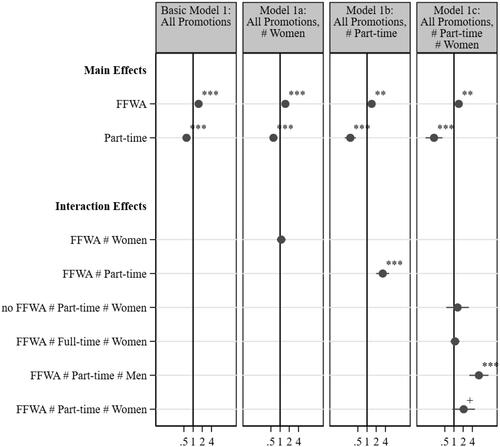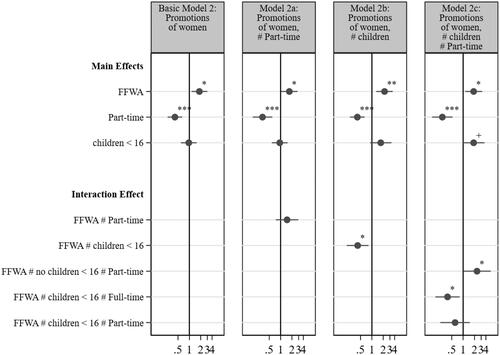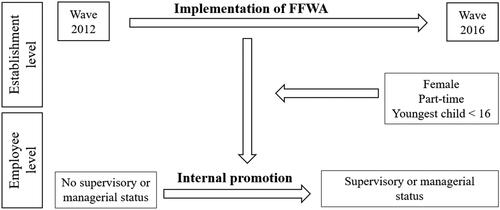Figures & data
Table 1. Promotions to management positions by gender, in the period 2012–2016, shares in percent.
Table 2. FFWA firm types: absence and presence of FFWA in establishments with 50 or more employees, 2012 compared to 2016, shares in percent.
Figure 2. FE logistic regression estimates (odds ratios): chances of advancing to management positions (Interaction variables: #women, #part-time). + p < 0.1, **p < 0.01, ***p < 0.001. Note: Restricted to employees in establishments with 50 or more employees with valid data in 2012/2016 who are employed in the same establishment, balanced panel. The dependent variable is the advancement to managerial or supervisory positions. N: 14,034 observations of 7017 employees. Table S2 in the Supplemental Online Material for a list of the control variables.
Source: Own calculations using LIAB_LM_9319_v1.

Figure 3. FE logistic regression estimates (odds ratios): women’s chances of advancing to management positions (Interactions: #part-time, # children). +p < 0.1, *p < 0.05, **p < 0.01, ***p < 0.001. Note: Restricted to female employees in establishments with 50 or more employees with valid data in 2012/2016 who are employed in the same establishment, balanced panel. The dependent variable is the advancement to managerial or supervisory positions. N: 2120 observations of 1060 women. See Table S2 in the Supplemental Online Material for a list of the control variables.
Source: Own calculations using LIAB_LM_9319_v1.

Supplemental Material
Download MS Word (19.4 MB)Data availability statement
The data used in this contribution are publicly accessible at the Research Data Centre (FDZ) of the Federal Employment Agency (BA) at the Institute for Employment Research (IAB) in Nuremberg, Germany. For the analyses, the linked-employer-employee-data (LIAB) longitudinal model 1975–2019, version 1 was used. The LIAB data are available at DOI: 10.5164/IAB.LIABLM7519.de.en.v1.
If you would like access to the computer programmes for replication purposes, please contact the author. The estimations were carried out with the statistical software package Stata, version 17 (StataCorp LLC., USA).

